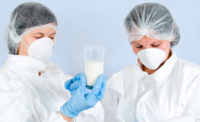Study: Food safety testing market worth $24.6B by 2023
The major factor driving the food safety testing market is the increase in global outbreaks of foodborne illnesses.

The food safety testing market is projected to grow from $17 billion in 2018 to $24.6 billion by 2023, at a CAGR of 7.7% during the forecast period, according to the new market research report, "Food Safety Testing Market by Target Tested (Pathogens, Pesticides, GMOs, Mycotoxin, and Allergens), Technology (Traditional and Rapid), Food Tested (Meat, Poultry, Seafood, Dairy, Processed Foods, and Fruits & Vegetables), and Region-Global Forecast to 2023", published by MarketsandMarkets, Northbrook, Ill.
The major factor driving the food safety testing market is the increase in global outbreaks of foodborne illnesses. Further, stringent food safety regulations, availability of advanced rapid technology, increase in demand for convenience and packaged food products, increase in outbreaks of chemical contamination in food processing industries and the rise in consumer awareness about food safety are also expected to drive the market.
The fruits and vegetables segment is projected to be the fastest-growing due to easy susceptibility to microbial and other contaminations, along with the growing number of tests for fruit and vegetables. Furthermore, high susceptibility to contamination of fruit and vegetables by different types of pathogens, pesticides and genetically modified organisms (GMOs) are also expected to drive the growth.
GMO testing is projected to grow at the highest CAGR during the forecast period. GMOs used for the growth of genetically modified food have several functional benefits, such as enhanced taste and quality, reduced maturation time, increased nutrient content and yield and stress tolerance and improved resistance to diseases, pests and herbicides. Increase in consumer awareness for GMOs in food, stringent regulatory restrictions on GMOs and efficient technological trends are expected to drive the global market for GMO testing.
Europe is estimated to account for the largest share of the market in 2018, primarily driven by growth in the German and UK markets, thanks to European food policies that have been extensively emphasized by the National Reference Laboratories (NRLs) and the European Reference Laboratories (EURLs) to maintain food standards and protect consumer health. The market is further fueled by the presence of major food safety testing companies, who are continuously investing and collaborating for the development of better and faster testing technologies.
Looking for a reprint of this article?
From high-res PDFs to custom plaques, order your copy today!




